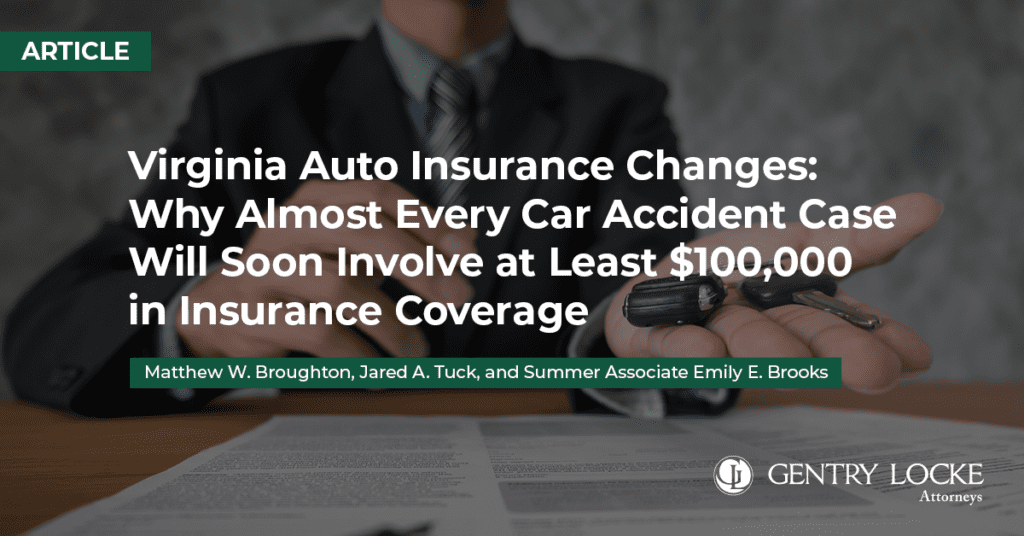Virginia Auto Insurance Changes: Why Almost Every Car Accident Case Will Soon Involve at Least $100,000 in Insurance Coverage

Article co-written by Matthew Broughton, Jared Tuck, and Summer Associate Emily Brooks
Virginia law has seen several recent changes regarding auto insurance, and this trend is continuing. Since July 1, 2023, three major changes have been enacted, with two taking effect in the near future. Here’s what you should know about these recent changes to the law and what impact these changes will have on personal injury cases arising from Virginia motor vehicle accidents.
I. Change #1: Elimination of the Liability Credit
Underinsured motorist coverage (UIM) and uninsured motorist coverage (UM) both act as a safety mechanism if you or your family are involved in a motor vehicle collision with an individual who either: (1) does not have enough insurance to cover the costs of your damages, or (2) does not have any insurance. In these situations, the amount of underinsured and uninsured motorist coverage you have will significantly impact the amount of money you can recover for your injuries.
As of July 1, 2023, the amount of damages an individual may recover from his/her own UIM is no longer reduced by the underinsured motorist’s liability coverage amount. Instead, the injured motorist can now obtain and benefit from the full amount of his/her underinsured motorist policy.[1] For example, let’s say Robert has $100,000 in underinsured motorist coverage, and he is injured by a motorist who has $50,000 in liability insurance coverage. Let’s assume that Robert’s total damages from the accident amount to $150,000. Before July 1, 2023, Robert was only able to collect $50,000 from his UIM, despite having a $100,000 policy. This is because the $50,000 liability insurance coverage of the motorist who caused the accident would be deducted from the total amount of underinsured motorist damages Robert could receive from his policy. After the July 1, 2023 change, Robert can collect the entire $100,000 from his UIM, receiving the full benefit of his policy. In other words, you are now able to enjoy the full benefits of your underinsured motorist policy.
The July 1, 2023 change allows a motorist to elect in writing to reduce his/her UIM coverage by the liability limits.[2] DO NOT LET AN INSURANCE AGENT TALK YOU INTO ELECTING TO REDUCE YOUR UIM LIMITS!
II. Change #2: Mandatory Auto Insurance
Effective July 1, 2024, a second major change to auto liability insurance under Virginia law has finally become a reality. This change requires every person applying for registration of a motor vehicle to have insurance on his/her vehicle.[3] Any owner who refuses or neglects to submit proof of automobile liability insurance coverage within 30 days of request by the Commissioner or duly authorized agent, will have his/her driver’s license, registration certificates, and license plates suspended until the owner of the motor vehicle has both: (1) furnished proof of the required liability insurance coverage, and (2) paid a $600 noncompliance fee.[4]
This requirement is a substantial change from the previous options available for motorists. Historically, motorists could register an uninsured motor vehicle by paying an annual $500 fee to the Department of Motor Vehicles in lieu of maintaining automobile liability insurance on the vehicle. As of July 1, 2024, this is no longer an option, and all motorists will be required to obtain the minimum levels of bodily injury liability insurance required under Virginia Code § 46.2-472.[5] Currently, this amount sits at $30,000 per bodily injury or death to one person in any one accident, and $60,000 for bodily injury or death to two or more persons in any one accident.[6] However, this amount will be increasing on January 1, 2025.
III. Change #3: Increase in Minimum Limits
Beginning on January 1, 2025, Virginia law will require all auto policies effective on or after that date to have a minimum liability limit of $50,000 per bodily injury or death to one person in any one accident and a minimum limit of $100,000 in UIM for bodily injury or death to two or more persons in any one accident.[7] This change will also increase the amount of uninsured and underinsured motorist coverage because Virginia law requires the UM/UIM limits to be at least equal to the minimum liability limit.[8] In other words, the minimum UM/UIM limit will also increase to $50,000 per person and $100,000 per accident.
IV. How These Changes Impact Virginia Personal Injury Cases
Ultimately, the new changes in Virginia auto insurance law will significantly increase the amount potentially recoverable for a plaintiff injured in a motor vehicle accident where there is limited insurance coverage.
Before the July 1, 2024 change mandating auto insurance, the worst-case scenario for a plaintiff injured in a crash was that both motorists were uninsured and had elected to pay the $500 uninsured motorist fee. In this scenario, there would not be any insurance coverage for the plaintiff to collect, and the plaintiff would be limited to pursuing the defendant’s personal assets.
With the July 1, 2023 change eliminating the liability credit, the July 1, 2024 change mandating auto insurance, and the January 1, 2025 change increasing the minimum limits to $50,000, almost every Virginia personal injury case arising out of a motor vehicle collision will involve at least $100,000 in insurance coverage.
This is because the defendant will be required to have $50,000 in liability coverage pursuant to Virginia Code § 46.2-472(B)(3), and the plaintiff will be required to have $50,000 in UIM pursuant to Virginia Code § 38.2-2202(B).[9] Given the elimination of the liability credit, a plaintiff with $100,000 in damages will be able to recover $50,000 from the defendant’s insurer and $50,000 from his/her UIM carrier. It should be noted that this example assumes that the plaintiff has not elected to reduce his/her UIM coverage by the liability limits.[10] In our experience, elections to reduce are uncommon because the default rule is that the July 1, 2023 change applies, and any election to reduce must be in writing.[11] However, if the plaintiff elected to reduce, then the worst case scenario would still be $50,000 in coverage, unless both the plaintiff and defendant failed to purchase auto insurance, which would be illegal under the July 1, 2024 change.
The amount of auto insurance applicable to a personal injury case can be a complicated issue that varies on a case-by-case basis. If you have been injured in a motor vehicle collision where the at-fault driver has no insurance coverage or limited insurance coverage, contact one of our personal injury attorneys who can evaluate all of the facts and circumstances of your case, determine the total amount of potentially applicable insurance coverage, and advise you of your legal remedies to obtain the most amount of compensation possible.
[1] Va. Code § 38.2-2206(B) (effective July 1, 2023).
[2] See Va. Code § 38.2-2202(C).
[3] Va. Code § 46.2-706 (effective July 1, 2024).
[4] Va. Code § 46.2-706(B) (effective July 1, 2024).
[5] Va. Code § 46.2-472.
[6] Va. Code § 46.2-472(A)(3).
[7] See Va. Code § 46.2-472(B)(3).
[8] Va. Code § 38.2-2202(B).
[9] See Va. Code § 46.2-472(B)(3); Va. Code § 38.2-2202(B) (requiring UM/UM limits to be “no lower than the financial responsibility limits required by § 46.2-472”).
[10] See Va. Code § 38.2-2202(C).
[11] See id.






